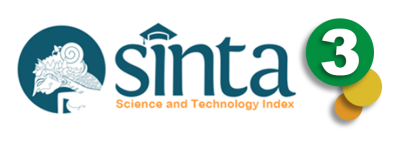ANALISA EKONOMI USAHATANI PADI DENGAN PESTISIDA ORGANIK URINE SAPI (Studi Kasus di Desa Sopet, Kecamatan Jangkar, Kabupaten Situbondo)
Abstract
The aimed to defermine the difference between the revenue and the efficient of cow urine organic pesticides with inorganic pesticides in the village of sopet. Nangger hemlet village distrets sopet jangkar is one of the objects that have a decent area planted with vice by using organic pesticides cow urine and distance with researchers location close enough to the researchers that helps smooth researchers, especially in terms of efficiency an time. The research method used is descriptive method, komparatif, is the systematic description on the facts as well as between fenomina were investigated.Whereas the comparative method is atype of research that is used to compare a variable between different subjects to the test on the presence or absence hepotesa the difference between the variable being examined. Determination of the respondents in the cencus done by takeing the data 23 heads of familly farming rice with organic pesticides cow urine and determination of respondent was conducted by randomly retrieving data 23 heads of rice farming families with inorganic pesticides. Method of data collection is done through observation, cencus and koisoner. With additional types of data in the study of which uses primary and secondary. Hipotesa testing data analysis techaves first by calculating the difference of rice and farm income hypotesis to the two to determine the efficiency of rice farming. The result of the first hypotesa revenves rice farming with cow urine organic pesticides nothing difference in carning after pesticides “ T ” with pesticides inorganic and second yield hepotesa, both are equally efficiency than inorganic pesticides.
Downloads
References
Andoko A. 2006. Budidaya Padi Secara Organik. Penebar Swadaya. Jakarta.
Anonim. 1978. Hijauan Makanan Ternak.Penuntun pembuatan padang pengembalaan.Direktorat Bina Produksi Peternakan. Dirjen Peternakan Jakarta.
_________. 2014. Purposive Sampling (Online) Tersedia: (www.portal-statistik.com). 26 Agustus 2015
_________. 2013a. Urine Sapi Di Buang Sayang. http://m.epetani.deptan.go.id /berita/urine-sapi-dibuang-sayang-7753. Diakses tanggal 6 April 2013
_______________b. Metode Penelitian: Populasi, Sampling, Teknik Acak. http://kelasarmansyah.wordpress.com/2013/03/23/metodepenelitian-populasi-sampling-dan-teknik-acak/. Diakses tanggal 23 Maret 2013
_______________c. Populasi dan Sampel. http://afidburhanuddin.wordpres.com /2013/09/24populasi-dan-sampel-4/. Diakses tanggal 24 september 2013
_______________d. Jenis Data Penelitian,http://www.informasi-pendidikan.com /2013/08/jenis-datapenelitian.html?m=1. Diakses tanggal 21 Agustus 2013
Azwar, S. 1997. MetodePenelitian. PustakaPelajar.Yogyakarta.
Harahap, S. S. 2011. Teori Akuntansi. Rada Grafindo Persada. Jakarta.
Husnan, Suad. 1992. Efisiensi Pasar Modal Indonesia. Jurnal Ekonomi Indonesia, April. Penerbit Buku Kompas Amazon.com
Jopie Jusuf.2008. Analisis kredit. Penerbit ANDI. Yogyakarta.
Kiose, Donald E., Weygant, Jerry J., Warfield, Terry D. 2007. Diterjemahkan oleh Emil Salim. Akuntansi Intermediate. Edisi Keduabelas. Jilid 2. Penerbit Erlangga. Yogyakarta.
Mulyadi. 2009. Akuntansi Biaya. UPP STIM YKPM.Yogyakarta.
Nazir, M, 2005.Metode Penelitian.PenerbitGhaliaPersada Indonesia.Jakarta.
Novizan, 2002. Membuat dan Memanfaatkan Pestisida Ramah Lingkungan. Agromedia pusat, Jakarta.
Nurhidayat, Purwendro S. 2009. Mengolah Sampah untuk Pupuk dan Pestisida Organik. Penebar Swadaya. Jakarta.
Poli. 1992. Pengantar Ilmu Ekonomi.Jakarta.PT.Gramedia Pustaka Utama. Jakarta.
Rahim, A. dan Hastuti, Diah Retno. 2007. Pengantar Teori danKasus. Ekonomika Pertanian. Penerbit Swadaya. Jakarta
Rahim, A. dan Hastuti. 2008. Ekonomika Pertanian. Penerbit Penebar Swadaya, Jakarta.
Rizal, Molide. 2009. Pemanfaatan Tanaman Arsiri sebagai Pestisida Nabati, Balitro. Bogor.
Santoso, Imam. 2010. Akuntansi Keuangan Menengah (Intermediate Accounting). Buku satu. Refika Aditama. Bandung.
Soekartawi. 1995.AnalisisUsahatani. PenerbitUniversitas Indonesia.Jakarta
__________. 2002. AnalisisUsahatani. UI- Press. Jakarta.
__________. 2005. Agribisnis Teori dan Aplikasinya. Raja Grafindo Persada.Jakarta.
__________. 2006. Ilmu Usahatani dan Penelitian Untuk Pengembangan Petani Kecil.Universitas Indonesia. Jakarta.
Soenandar M, Aeni MN, Raharjo A. 2010. Petunjuk Praktis Membuat Pestisida Organik. Agromedia Pustaka. Jakarta.
SubagyoP. danDjarwanto, 2005. Statistika Induktif. Penerbit BPFE-Anggota IKAPI.Yogyakarta.
Sudarman.Ari. 2004. Definisi Produksi. Dalam, http://sbrrhapsody.blogspot.com /2012/07/pengertian-produksi-fungsi-produksi.html. Diakses tanggal 28 juli 2013
Sudarmo, S. 2005. Pestisida Nabati. Penerbit Kanisius Jakarta.
Sudarsono.1991. Pengantar Ekonomi Mikro. LP3ES. Jakarta.
Sugiarto. 2002. Pengertian produksi. Dalam, http://sbrrhapsody.blogspot.com /2012/07/pengertian-produksi-fungsi-produksi.html.Diakses tanggal 8 juli 2013
Sukirno, 2006. Ekonomi Pembangunan: Proses, Masalah, dan Dasar Kebijakan. Kencana Penada Media Group.
Suratiyah, K. 2008. Ilmu Usahatani. Penebar Swadaya. Jakarta.
Warasfarm.2013. Potensi Urine Sapi Sebagai Pupuk Organik Cair. http://warasfarm.wordpress.com/2013/01/22/potensi-urine-sapi-sebagai-pupuk-organik-cair-poc/. Diakses tanggal 6 April 2013

This work is licensed under a Creative Commons Attribution 4.0 International License.






















